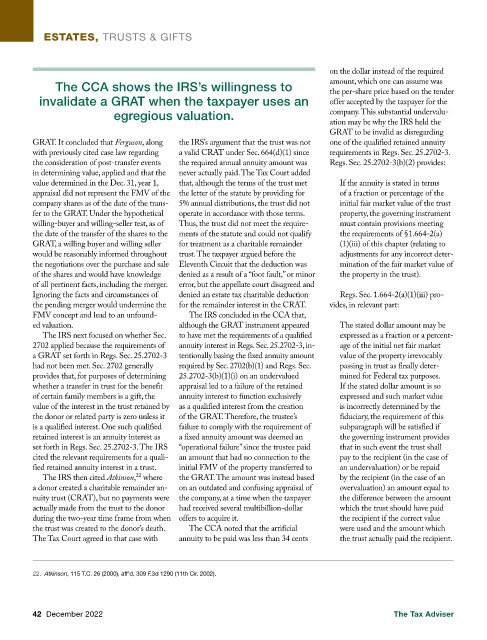Page 651 - TaxAdviser_2022
P. 651
ESTATES, TRUSTS & GIFTS
on the dollar instead of the required
The CCA shows the IRS’s willingness to amount, which one can assume was
the per-share price based on the tender
invalidate a GRAT when the taxpayer uses an offer accepted by the taxpayer for the
egregious valuation. company. This substantial undervalu-
ation may be why the IRS held the
GRAT to be invalid as disregarding
GRAT. It concluded that Ferguson, along the IRS’s argument that the trust was not one of the qualified retained annuity
with previously cited case law regarding a valid CRAT under Sec. 664(d)(1) since requirements in Regs. Sec. 25.2702-3.
the consideration of post-transfer events the required annual annuity amount was Regs. Sec. 25.2702-3(b)(2) provides:
in determining value, applied and that the never actually paid. The Tax Court added
value determined in the Dec. 31, year 1, that, although the terms of the trust met If the annuity is stated in terms
appraisal did not represent the FMV of the the letter of the statute by providing for of a fraction or percentage of the
company shares as of the date of the trans- 5% annual distributions, the trust did not initial fair market value of the trust
fer to the GRAT. Under the hypothetical operate in accordance with those terms. property, the governing instrument
willing-buyer and willing-seller test, as of Thus, the trust did not meet the require- must contain provisions meeting
the date of the transfer of the shares to the ments of the statute and could not qualify the requirements of §1.664-2(a)
GRAT, a willing buyer and willing seller for treatment as a charitable remainder (1)(iii) of this chapter (relating to
would be reasonably informed throughout trust. The taxpayer argued before the adjustments for any incorrect deter-
the negotiations over the purchase and sale Eleventh Circuit that the deduction was mination of the fair market value of
of the shares and would have knowledge denied as a result of a “foot fault,” or minor the property in the trust).
of all pertinent facts, including the merger. error, but the appellate court disagreed and
Ignoring the facts and circumstances of denied an estate tax charitable deduction Regs. Sec. 1.664-2(a)(1)(iii) pro-
the pending merger would undermine the for the remainder interest in the CRAT. vides, in relevant part:
FMV concept and lead to an unfound- The IRS concluded in the CCA that,
ed valuation. although the GRAT instrument appeared The stated dollar amount may be
The IRS next focused on whether Sec. to have met the requirements of a qualified expressed as a fraction or a percent-
2702 applied because the requirements of annuity interest in Regs. Sec. 25.2702-3, in- age of the initial net fair market
a GRAT set forth in Regs. Sec. 25.2702-3 tentionally basing the fixed annuity amount value of the property irrevocably
had not been met. Sec. 2702 generally required by Sec. 2702(b)(1) and Regs. Sec. passing in trust as finally deter-
provides that, for purposes of determining 25.2702-3(b)(1)(i) on an undervalued mined for Federal tax purposes.
whether a transfer in trust for the benefit appraisal led to a failure of the retained If the stated dollar amount is so
of certain family members is a gift, the annuity interest to function exclusively expressed and such market value
value of the interest in the trust retained by as a qualified interest from the creation is incorrectly determined by the
the donor or related party is zero unless it of the GRAT. Therefore, the trustee’s fiduciary, the requirement of this
is a qualified interest. One such qualified failure to comply with the requirement of subparagraph will be satisfied if
retained interest is an annuity interest as a fixed annuity amount was deemed an the governing instrument provides
set forth in Regs. Sec. 25.2702-3. The IRS “operational failure” since the trustee paid that in such event the trust shall
cited the relevant requirements for a quali- an amount that had no connection to the pay to the recipient (in the case of
fied retained annuity interest in a trust. initial FMV of the property transferred to an undervaluation) or be repaid
The IRS then cited Atkinson,22 where the GRAT. The amount was instead based by the recipient (in the case of an
a donor created a charitable remainder an- on an outdated and confusing appraisal of overvaluation) an amount equal to
nuity trust (CRAT), but no payments were the company, at a time when the taxpayer the difference between the amount
actually made from the trust to the donor had received several multibillion-dollar which the trust should have paid
during the two-year time frame from when offers to acquire it. the recipient if the correct value
the trust was created to the donor’s death. The CCA noted that the artificial were used and the amount which
The Tax Court agreed in that case with annuity to be paid was less than 34 cents the trust actually paid the recipient.
22. Atkinson, 115 T.C. 26 (2000), aff’d, 309 F.3d 1290 (11th Cir. 2002).
42 December 2022 The Tax Adviser

